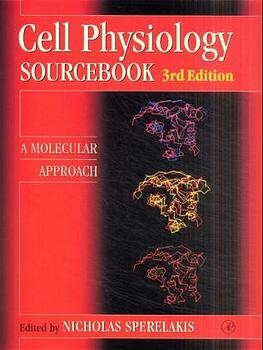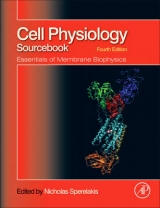
Cell Physiology Source Book
Academic Press Inc (Verlag)
978-0-12-656977-3 (ISBN)
- Titel erscheint in neuer Auflage
- Artikel merken
This authoritative book gathers together a broad range of ideas and topics that define the field. It provides clear, concise, and comprehensive coverage of all aspects of cellular physiology from fundamental concepts to more advanced topics. The Third Edition contains substantial new material. Most chapters have been thoroughly reworked. The book includes chapters on important topics such as sensory transduction, the physiology of protozoa and bacteria, the regulation of cell division, and programmed cell death.
Professor Sperelakis currently is Professor and Chairman Emeritus of Physiology and Biophysics at the College of Medicine at the University of Cincinnati. He is a cell physiologist specializing in cellular electrophysiology. Dr Sperelakis received a B.S. in Chemistry, M.S. in Physiology in 1955, and a Ph.D. in Physiology in 1957, all from the University of Illinois, Urbana. He was also trained in electronics, receiving a certificate from the U.S. Navy & Marine Corps Electronics School in Treasure Island, San Francisco. He served in the U.S. Marine Corps during the Korean War. Dr. Sperelakis is the author/co-author of over 550 scientific articles in journals and books. He has lectured at numerous universities worldwide and at international conferences/symposia. He has also trained many postdoctoral fellows and graduate students, and has been a visiting professor at several foreign universities. Professor Sperelakis has served on a number of journal editorial boards. He is a member of numerous professional societies and has served on the Council for several of them. He has served on the science program advisory committees for various international conferences and has organized several conferences. Dr. Sperelakis was an Established Investigator of the American Heart Association (AHA), Fellow at the Marine Biological Laboratory (Woods Hole), and elected Fellow of the American College of Cardiology (FACC). He received Awards for research excellence from Ohio AHA in 1995 and SW Ohio in 1996. His listings include Who's Who in the World, in America, in Science and Engineering, in Medicine and Healthcare, and in American Education.
Section I Biophysical Chemistry, Metabolism, Second 1. Biophysical Chemistry of Physiological Solutions 2. Physiological Structure and Function of Proteins 3. Structural Organization and Properties of Appendix: Exponential Time Course Membrane Lipids 4. Cell Membranes and Model Membranes 5. Lipid Domains and Biological Membrane Function 6. Ultrastructure of Cells 7. Energy Production and Metabolism 8. Physiology of Mitochondria 9. Signal Transduction 10. Calcium as an Intracellular Second Messenger: Mediation by Calcium-Binding Proteins 11. Regulation of Cellular Functions by Extracellular Calcium 12. Cellular Responses to Hormones
Section II Membrane Potential, Transport Physiology, Pumps, and Exchangers 13. Diffusion and Permeability 14. Origin of Resting Membrane Potentials 15. Gibbs-Donnan Equilibrium Potentials 16. Mechanisms of Carrier-Mediated Transport: Facilitated Diffusion, Cotransport, and Countertransport 17. Sodium Pump Function 18. Ca2 +-ATPases 19. Na+-Ca2+ Exchange Currents 20. Intracellular Chloride Regulation 21. Osmosis and Regulation of Cell Volume 22. Intracellular pH Regulation 23. Membrane Transport in Red Blood Cells
Section III Membrane Excitability and Ion Channels 24. Cable Properties and Propagation of Action Potentials 25. Electrogenesis of Membrane Excitability 26. Patch-Clamp Techniques and Analysis 27. Structure and Mechanism of Voltage-Gated Ion Channels 28. Biology of Neurons 29. Ion Channels in Nonexcitable Cells 30. Ion Channels in Sperm 31. Biology of Gap Junctions 32. Biophysics of the Nuclear Envelope 33. Regulation of Ion Channels by Phosphorylation 34. Direct Regulation of Ion Channels by G Proteins 35. Developmental Changes in Ion Channels 36. Regulation of Ion Channels by Membrane Proteins and Cytoskeleton
Section IV Ion Channels as Targets for Toxins, Drugs, and Genetic Diseases 37. Ion Channels as Targets for Toxins 38. Ion Channels as Targets for Drugs 39. Ion Channels as Targets for Disease
Section V Synaptic Transmission and Sensory Transduction 40. Ligand-Gated Ion Channels 41. Synaptic Transmission 42. Excitation-Secretion Coupling 43. Stimulus-Response Coupling in Metabolic Sensor Cells 44. Mechanosensitive Ion Channels in Eukaryotic Cells 45. Sensory Receptors and Mechanotransduction 46. Acoustic Transduction
Appendix: Self-Referencing Electrodes for the Measurement of Extracellular Potential and Chemical Gradients 47. Cyclic Nucleotide-Gated Ion Channels 48. Visual Transduction 49. Gustatory and Olfactory Sensory Transduction 50. Electroreceptors and Magnetoreceptors
Section VI Muscle and Other Contractile Systems 51. Skeletal Muscle Action Potentials 52. Cardiac Action Potentials 53. Smooth Muscle Action Potentials and Electrical Profiles 54. Excitation-Contraction Coupling in Skeletal Muscle 55. Ca2+ Release from Sarcoplasmic Reticulum in Muscle 56. Contraction of Muscles 57. Amoeboid Movement, Cilia, and Flagella 58. Centrin-Based Contraction and Bacterial Flagella 59. Effects of High Pressure on Cellular Processes 60. Electrocytes of Electric Fish
Section VII Protozoa and Bacteria 61. Physiological Adaptations of Protists 61. Physiology of Prokaryotic Cells
Section VIII Plant Cells, Photosynthesis, and Bioluminescence 63. Plant Cell Physiology 64. Photosynthesis 65. Bioluminescence
Section IX Cell Division and Programmed Cell Death 66. Regulation of Cell Division in Higher Eukaryotes 67. Cancer Cell Properties 68. Apoptosis 69. Effects of Ionizing Radiation on Cells 70. Review of Electricity and Cable Properties
| Erscheint lt. Verlag | 14.8.2001 |
|---|---|
| Verlagsort | San Diego |
| Sprache | englisch |
| Maße | 216 x 279 mm |
| Gewicht | 2890 g |
| Themenwelt | Naturwissenschaften ► Biologie ► Zellbiologie |
| ISBN-10 | 0-12-656977-0 / 0126569770 |
| ISBN-13 | 978-0-12-656977-3 / 9780126569773 |
| Zustand | Neuware |
| Informationen gemäß Produktsicherheitsverordnung (GPSR) | |
| Haben Sie eine Frage zum Produkt? |
aus dem Bereich



